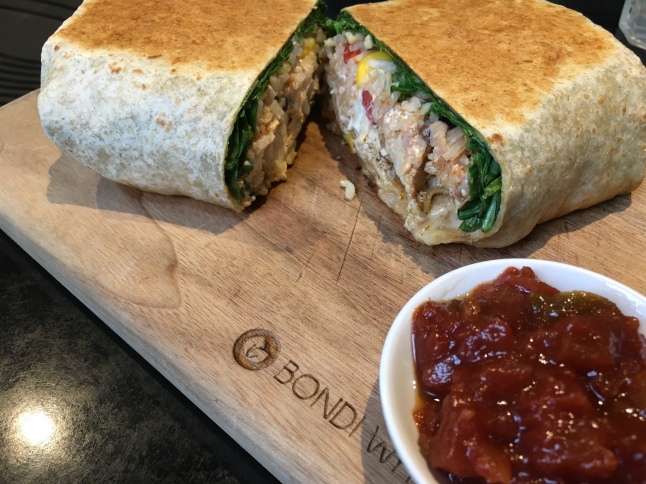
A Sydney food adventure for ½ of the Team Glasses Food Blog, yes you’ve read that right. I found myself in Sydney for a week because of work, so I decided to sample some places I’ve had here. First of them was Bondi Wholefoods.
After the eight-hour flight and another 30 minutes of train and walking, my boss and I decided to try something healthy and organic near where we’ll be staying.
It was an open air dining experience, with cozy chairs and sleek black facade complemented the plants around the place. They even have ready to eat sandwiches, wraps, and even cans and bottles of kombucha near their counter. For my meal here, I’ve tried the Slow Cooked Bio Lamb Wrap.

Slow Cooked Bio Lamb Wrap
The combination of smashed avocado, grilled eggplants, roasted pepper strips, and baby spinach was both fresh and well thought out. The biodynamic lamb was unfortunately much too bland for my preferences. The wrap that held these together was amazingly great at doing so without turning soggy or breaking up in my hands. Alongside this, the tzatziki on the side complemented the wrap.
For breakfast the next day, I tried their Spiced Organic Chicken Wrap (toasted) with some hot chocolate mixed with soy milk.

Spiced Organic Chicken Wrap
The texture of the wrap was much better with the slight crunch on every bite. The lime, coriander, brown rice, tomatoes, sour cream, cheddar cheese, plus the accompanying chipotle salsa made for a wonderful tex-mex burrito-style experience altogether. It was much more to my liking.

The hot chocolate, of course, is always a pleasing site and a good accompaniment to the Spiced Organic Chicken Wrap.
Food Score: 4/5: The gestalt of my food experience here at Bondi Wholefoods was pretty good overall, despite the first encounter. However, that’s more of my taste preference than anything else.
Ambiance Score: 4.5/5: Especially during the wee hours of the morning, the quiet start of the day while sitting around with the greenery is already something to look forward to dining here.
Service Score: 4/5: The service we received here was warm and accommodating all throughout our time dining at Bondi Wholefoods.
GERD Score: 4.5/5: Aside from catering to many food restrictions, outlining the ingredients used to make the food is always a helpful guide for everyone dealing with GERD.
Neurodivergent Score: 4/5: The selection of non trigger foods such as gluten free items is a great relief to neurodivergent diners. Another plus is that additives are used sparingly, if at all, in their dishes.
Team Glasses Score: 4/5: For the health conscious or even someone looking for a filling meal that doesn’t make him or her guilty, Bondi Wholefoods is the place to go.























